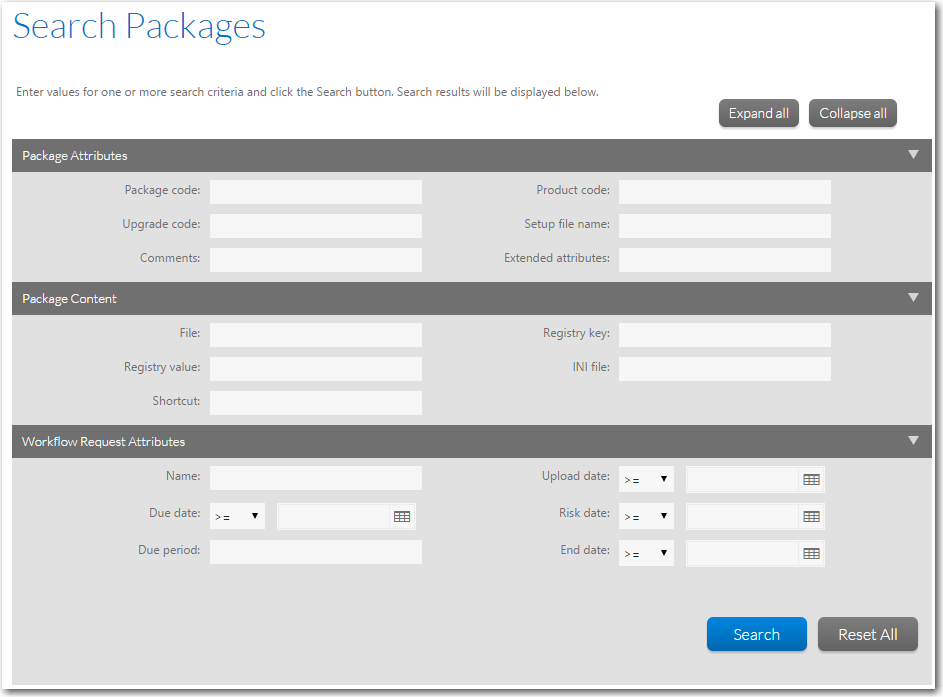Searching for a Package on the Search Packages Page
AdminStudio Enterprise Server 2023 | Reports
Edition:Reports is included with AdminStudio Enterprise Edition and with Workflow Manager.
By default, all of the packages in the connected AdminStudio Application Catalog are listed on the Search Packages page. However, you can filter the list of packages displayed in the package tree to display only those packages that meet specific search criteria. The search criteria are grouped into three categories:
| • | Package Attributes—Search by common properties assigned to packages. See Package Attributes. |
| • | Package Content—Search by files, registry entries, .ini files, or shortcuts contained in the package. See Package Content. |
| • | Workflow Request Attributes—Search by information related to a package’s associated workflow request. See Workflow Request Attributes. |
To filter the list of packages displayed in the package tree to display only those packages that meet specific search criteria, perform the following steps.
To search for a package on the Search Packages page:
| 1. | In the Search Packages area of the Search Packages page, expand the criteria category that you want to use by clicking the arrow. When all three categories are expanded, the following fields are available: |

| 2. | Enter values in the criteria fields that you want to search on. You can search for packages in the Application Catalog based on metadata in three categories: |
| • | Package Attributes—Search by properties assigned to the package. See Package Attributes. |
| • | Package Content—Search by files, registry entries, .ini files, or shortcuts contained in the package. See Package Content. |
| • | Workflow Request Attributes—Search by information related to a package’s associated workflow request. See Workflow Request Attributes. |
| 3. | After you have entered the search criteria, click Search. The packages that meet the criteria are now listed. |
You can search for packages in a catalog based on one or more of any of the following package attribute metadata:
|
Metadata |
Description |
|
Package Code |
Enter the GUID that identifies a particular Windows Installer .msi package. The Package Code associates an .msi file with an application or product and is represented as a string GUID—a text string that has a special format: {XXXXXXXX-XXXX-XXXX-XXXX-XXXXXXXXXXXX} where each X character is a hex digit (0 through 9 or uppercase A through F). |
|
Product Code |
Enter the GUID that uniquely identifies the particular product release of a package. The ProductCode is a Windows Installer property and is represented as a string GUID—a text string that has a special format: {XXXXXXXX-XXXX-XXXX-XXXX-XXXXXXXXXXXX} where each X character is a hex digit (0 through 9 or uppercase A through F). |
|
Upgrade Code |
Enter the GUID that identifies the family of products that are in the same upgrade path. The UpgradeCode is a Windows Installer property and is represented as a string GUID—a text string that has a special format: {XXXXXXXX-XXXX-XXXX-XXXX-XXXXXXXsXXXXX} where each X character is a hex digit (0 through 9 or uppercase A through F). Note:Each stand-alone product usually has its own UpgradeCode GUID. Every version of XYZ Product typically uses the same GUID for the UpgradeCode. In other words, Product A Version 1.0 has the same UpgradeCode as Product A Version 2.0, but has a different UpgradeCode than Product B. |
|
Setup File Name |
Name of the file that was imported into the Application Catalog. |
|
Comments |
Enter the text of any comments associated with the package. |
|
Extended Attributes |
Enter the value of any of the Extended Attributes associated with the package. |
You can search for packages in a catalog based on one or more of any of the following Package Content metadata
|
Metadata |
Description |
|
File |
Enter the file name of one of the files in the package. |
|
Registry Key |
Enter a registry key to search on. |
|
Registry Value |
Enter a registry value to search on. |
|
INI File |
Enter any changes to an .ini file that are made when the product is installed. |
|
Shortcut |
Enter the name of a shortcut that is created when the product is installed. |
You can search for packages in a catalog based on one or more of any of the following attributes of the package’s associated workflow request:
|
Metadata |
Description |
|
Name |
Enter the name of the package’s associated workflow request. |
|
Upload Date |
Enter the date the workflow request was created. |
|
Due Date |
Enter the date the workflow request is scheduled to be completed, based upon its value for Application Due Period. |
|
Risk Date |
Enter the date at which the workflow request’s status will change to At Risk, which is based upon its value for Application At Risk Period. |
|
Due Period |
Enter, in days, the length of time this workflow request needs to be completed in order to meet its project’s Service Level Agreement (SLA) requirements. |
|
End Date |
Enter the date the workflow request was completed. |